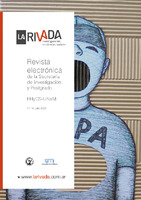La epistemología de Lotman : analogía, cultura, mundo
Lotman’s epistemology : analogy, culture, world
| dc.creator | Gherlone, Laura | |
| dc.date.accessioned | 2022-08-01T11:10:04Z | |
| dc.date.available | 2022-08-01T11:10:04Z | |
| dc.date.issued | 2020-05-14 | |
| dc.identifier.citation | Gherlone, L. (2020). La epistemología de Lotman: analogía, cultura, mundo= Lotman’s epistemology: analogy, culture, world. Posadas (Misiones): UNaM. FHyCS; 8(14), 240-264. | es_AR |
| dc.identifier.issn | 2347-1085 | |
| dc.identifier.other | RLR-189 | |
| dc.identifier.uri | https://hdl.handle.net/20.500.12219/3255 | |
| dc.description | Fil: Gherlone, Laura. Universidad Católica Argentina. PICTO-FONCyT; Argentina. | es_AR |
| dc.description | Fil: Gherlone, Laura. Instituto Universitario Sophia; Italia. | |
| dc.description.abstract | Según Jeanne Parain-Vial (y otros), los humanos se caracterizan por su necesidad de utilizar analogías junto con la lógica y la inteligibilidad, y esto se manifiesta mediante una investigación constante -dentro del campo científico- de modelos que puedan, en algunos aspectos, sacar a la luz algunas propiedades de la realidad, es decir, ser análogos a ella. Gracias a la analogía, la cognoscibilidad de las cosas no se agota en un solo modelo de conocimiento, sino que se revela mediante formas de compresión diversas y autónomas. Como también señalaron Iuri Lotman y Borís Uspenski, el pensamiento mítico fue el primero en postular la posibilidad de establecer una relación de semejanza entre realidades muy diferentes, como en el modelo cosmológico arquetípico del mundo: una posibilidad que, según explican, ha sobrevivido en el hombre post-arcaico, lo que constituye un elemento esencial en la actividad cognitiva y en el modelado científico. Este artículo habla específicamente sobre el uso de la analogía en la teoría semiótica de Lotman y su valor heurístico y epistemológico. | es_AR |
| dc.description.abstract | According to Jeanne Parain-Vial and others, humans are characterized by their need for analogy, together with the need for logic and intelligibility, and this need is expressed by a continuous research of models in the scientific field that can, in some aspects, bring to light some properties of reality, namely be analogous of them. The knowability of things is founded on analogy; thus, they are not exhausted by a single model of knowledge but rather through multiple and autonomous forms of comprehension. As also pointed out by Juri Lotman and Boris Uspenskij, mythical thought was the first to postulate the possibility of establishing a relationship of likeness among very different realities, as in the archetypical cosmological model of world: a possibility that, as they explain, has survived in post-archaic man, constituting a fundamental component of cognitive activity and scientific modelling. The article is dedicated to the use of analogy in Lotmanian semiotic theorization and to its heuristicand epistemological value. | en |
| dc.format | application/pdf | |
| dc.format.extent | 1.173 MB | |
| dc.language.iso | spa | es_AR |
| dc.publisher | Universidad Nacional de Misiones. Facultad de Humanidades y Ciencias Sociales. Secretaría de Investigación y Posgrado | es_AR |
| dc.relation | info:eu-repo/semantics/altIdentifier/urn/http://www.larivada.com.ar/index.php/ediciones-anteriores/134-numero-14-julio-2020/4-traducciones/263-la-epistemologia-de-lotman | |
| dc.rights | info:eu-repo/semantics/openAccess | |
| dc.rights.uri | http://creativecommons.org/licenses/by-nc-sa/4.0/ | |
| dc.subject | Traducciones | es_AR |
| dc.subject | Lotman | es_AR |
| dc.subject | Semiótica | es_AR |
| dc.subject | Epistemología | es_AR |
| dc.subject | Analogía | es_AR |
| dc.title | La epistemología de Lotman : analogía, cultura, mundo | es_AR |
| dc.title | Lotman’s epistemology : analogy, culture, world | |
| dc.type | info:eu-repo/semantics/article | |
| dc.type | info:ar-repo/semantics/artículo | |
| dc.type | info:eu-repo/semantics/publishedVersion |
Files in this item
This item appears in the following Collection(s)
-
Revista La Rivada [327]
En esta colección se depositan los artículos publicados en la Revista digital La Rivada, una publicación semestral de la SINVyP-FHyCS-UNaM.




